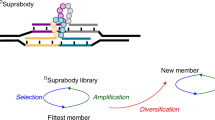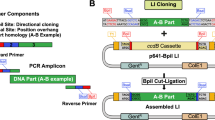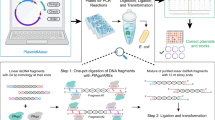Abstract
Engineered zinc-finger nucleases (ZFNs) form the basis of a broadly applicable method for targeted, efficient modification of eukaryotic genomes. In recent work, we described OPEN (oligomerized pool engineering), an 'open-source,' combinatorial selection-based method for engineering zinc-finger arrays that function well as ZFNs. We have also shown in direct comparisons that the OPEN method has a higher success rate than previously described 'modular-assembly' methods for engineering ZFNs. OPEN selections are carried out in Escherichia coli using a bacterial two-hybrid system and do not require specialized equipment. Here we provide a detailed protocol for carrying out OPEN to engineer zinc-finger arrays that have a high probability of functioning as ZFNs. Using OPEN, researchers can generate multiple, customized ZFNs in ∼8 weeks.
This is a preview of subscription content, access via your institution
Access options
Subscribe to this journal
Receive 12 print issues and online access
$259.00 per year
only $21.58 per issue
Buy this article
- Purchase on Springer Link
- Instant access to full article PDF
Prices may be subject to local taxes which are calculated during checkout








Similar content being viewed by others
References
Cathomen, T. & Joung, J.K. Zinc-finger nucleases: the next generation emerges. Mol. Ther. 16, 1200–1207 (2008).
Porteus, M.H. & Carroll, D. Gene targeting using zinc finger nucleases. Nat. Biotechnol. 23, 967–973 (2005).
Durai, S. et al. Zinc finger nucleases: custom-designed molecular scissors for genome engineering of plant and mammalian cells. Nucleic Acids Res. 33, 5978–5990 (2005).
Carroll, D. Progress and prospects: zinc-finger nucleases as gene therapy agents. Gene Ther. 15, 1463–1468 (2008).
Wu, J., Kandavelou, K. & Chandrasegaran, S. Custom-designed zinc finger nucleases: what is next? Cell Mol. Life Sci. 64, 2933–2944 (2007).
Camenisch, T.D., Brilliant, M.H. & Segal, D.J. Critical parameters for genome editing using zinc finger nucleases. Mini. Rev. Med. Chem. 8, 669–676 (2008).
Kim, Y.G., Shi, Y., Berg, J.M. & Chandrasegaran, S. Site-specific cleavage of DNA-RNA hybrids by zinc finger/FokI cleavage domain fusions. Gene 203, 43–49 (1997).
Kim, Y.G., Cha, J. & Chandrasegaran, S. Hybrid restriction enzymes: zinc finger fusions to Fok I cleavage domain. Proc. Natl. Acad. Sci. USA 93, 1156–1160 (1996).
Mani, M., Smith, J., Kandavelou, K., Berg, J.M. & Chandrasegaran, S. Binding of two zinc finger nuclease monomers to two specific sites is required for effective double-strand DNA cleavage. Biochem. Biophys. Res. Commun. 334, 1191–1197 (2005).
Smith, J. et al. Requirements for double-strand cleavage by chimeric restriction enzymes with zinc finger DNA-recognition domains. Nucleic Acids Res. 28, 3361–3369 (2000).
Maeder, M.L. et al. Rapid 'open-source' engineering of customized zinc-finger nucleases for highly efficient gene modification. Mol. Cell. 31, 294–301 (2008).
Bibikova, M., Beumer, K., Trautman, J.K. & Carroll, D. Enhancing gene targeting with designed zinc finger nucleases. Science 300, 764 (2003).
Bibikova, M., Golic, M., Golic, K.G. & Carroll, D. Targeted chromosomal cleavage and mutagenesis in Drosophila using zinc-finger nucleases. Genetics 161, 1169–1175 (2002).
Santiago, Y. et al. Targeted gene knockout in mammalian cells by using engineered zinc-finger nucleases. Proc. Natl. Acad. Sci. USA 105, 5809–5814 (2008).
Miller, J.C. et al. An improved zinc-finger nuclease architecture for highly specific genome editing. Nat. Biotechnol. 25, 778–785 (2007).
Lombardo, A. et al. Gene editing in human stem cells using zinc finger nucleases and integrase-defective lentiviral vector delivery. Nat. Biotechnol. 25, 1298–1306 (2007).
Perez, E.E. et al. Establishment of HIV-1 resistance in CD4+ T cells by genome editing using zinc-finger nucleases. Nat. Biotechnol. 26, 808–816 (2008).
Doyon, Y. et al. Heritable targeted gene disruption in zebrafish using designed zinc-finger nucleases. Nat. Biotechnol. 26, 702–708 (2008).
Meng, X., Noyes, M.B., Zhu, L.J., Lawson, N.D. & Wolfe, S.A. Targeted gene inactivation in zebrafish using engineered zinc-finger nucleases. Nat. Biotechnol. 26, 695–701 (2008).
Foley, J.E. et al. Rapid mutation of endogenous zebrafish genes using zinc finger nucleases made by oligomerized pool engineering. PLoS ONE 4, e4348 (2009).
Lloyd, A., Plaisier, C.L., Carroll, D. & Drews, G.N. Targeted mutagenesis using zinc-finger nucleases in Arabidopsis. Proc. Natl. Acad. Sci. USA 102, 2232–2237 (2005).
Wright, D.A. et al. High-frequency homologous recombination in plants mediated by zinc-finger nucleases. Plant J. 44, 693–705 (2005).
Porteus, M.H. & Baltimore, D. Chimeric nucleases stimulate gene targeting in human cells. Science 300, 763 (2003).
Moehle, E.A. et al. Targeted gene addition into a specified location in the human genome using designed zinc finger nucleases. Proc. Natl. Acad. Sci. USA 104, 3055–3060 (2007).
Urnov, F.D. et al. Highly efficient endogenous human gene correction using designed zinc-finger nucleases. Nature 435, 646–651 (2005).
Beumer, K., Bhattacharyya, G., Bibikova, M., Trautman, J.K. & Carroll, D. Efficient gene targeting in Drosophila with zinc-finger nucleases. Genetics 172, 2391–2403 (2006).
Beumer, K.J. et al. Efficient gene targeting in Drosophila by direct embryo injection with zinc-finger nucleases. Proc. Natl. Acad. Sci. USA 105, 19821–19826 (2008).
Morton, J., Davis, M.W., Jorgensen, E.M. & Carroll, D. Induction and repair of zinc-finger nuclease-targeted double-strand breaks in Caenorhabditis elegans somatic cells. Proc. Natl. Acad. Sci. USA 103, 16370–16375 (2006).
Cai, C.Q. et al. Targeted transgene integration in plant cells using designed zinc finger nucleases. Plant. Mol. Biol. 69, 699–709 (2009).
Townsend, J.A. et al. High frequency modification of plant genes using engineered zinc finger nucleases. Nature 459, 442–445 (2009).
Hurt, J.A., Thibodeau, S.A., Hirsh, A.S., Pabo, C.O. & Joung, J.K. Highly specific zinc finger proteins obtained by directed domain shuffling and cell-based selection. Proc. Natl. Acad. Sci. USA 100, 12271–12276 (2003).
Cornu, T.I. et al. DNA-binding specificity is a major determinant of the activity and toxicity of zinc-finger nucleases. Mol. Ther. 16, 352–358 (2008).
Pruett-Miller, S.M., Connelly, J.P., Maeder, M.L., Joung, J.K. & Porteus, M.H. Comparison of zinc finger nucleases for use in gene targeting in mammalian cells. Mol. Ther. 16, 707–717 (2008).
Fu, F. et al. Zinc Finger Database (ZiFDB): a repository for information on C2H2 zinc fingers and engineered zinc-finger arrays. Nucleic Acids Res. 37, D279–D283 (2009).
Sander, J.D., Zaback, P., Joung, J.K., Voytas, D.F. & Dobbs, D. Zinc finger targeter (ZiFiT): an engineered zinc finger/target site design tool. Nucleic Acids Res. 35, W599–W605 (2007).
Porteus, M.H. Mammalian gene targeting with designed zinc finger nucleases. Mol. Ther. 13, 438–446 (2006).
Alwin, S. et al. Custom zinc-finger nucleases for use in human cells. Mol. Ther. 12, 610–617 (2005).
Mani, M., Kandavelou, K., Dy, F.J., Durai, S. & Chandrasegaran, S. Design, engineering, and characterization of zinc finger nucleases. Biochem. Biophys. Res. Commun. 335, 447–457 (2005).
Segal, D.J. et al. Evaluation of a modular strategy for the construction of novel polydactyl zinc finger DNA-binding proteins. Biochemistry 42, 2137–2148 (2003).
Segal, D.J. The use of zinc finger peptides to study the role of specific factor binding sites in the chromatin environment. Methods 26, 76–83 (2002).
Segal, D.J. & Barbas, C.F. III . Custom DNA-binding proteins come of age: polydactyl zinc-finger proteins. Curr. Opin. Biotechnol. 12, 632–637 (2001).
Mandell, J.G. & Barbas, C.F. III. Zinc finger tools: custom DNA-binding domains for transcription factors and nucleases. Nucleic Acids Res. 34, W516–W523 (2006).
Beerli, R.R. & Barbas, C.F. III. Engineering polydactyl zinc-finger transcription factors. Nat. Biotechnol. 20, 135–141 (2002).
Bae, K.H. et al. Human zinc fingers as building blocks in the construction of artificial transcription factors. Nat. Biotechnol. 21, 275–280 (2003).
Liu, Q., Xia, Z., Zhong, X. & Case, C.C. Validated zinc finger protein designs for all 16 GNN DNA triplet targets. J. Biol. Chem. 277, 3850–3856 (2002).
Ramirez, C.L. et al. Unexpected failure rates for modular assembly of engineered zinc-fingers. Nat. Methods 5, 374–375 (2008).
Wolfe, S.A., Grant, R.A., Elrod-Erickson, M. & Pabo, C.O. Beyond the 'recognition code': structures of two Cys2His2 zinc finger/TATA box complexes. Structure 9, 717–723 (2001).
Wolfe, S.A., Greisman, H.A., Ramm, E.I. & Pabo, C.O. Analysis of zinc fingers optimized via phage display: evaluating the utility of a recognition code. J. Mol. Biol. 285, 1917–1934 (1999).
Elrod-Erickson, M., Rould, M.A., Nekludova, L. & Pabo, C.O. Zif268 protein-DNA complex refined at 1.6 A: a model system for understanding zinc finger-DNA interactions. Structure 4, 1171–1180 (1996).
Isalan, M., Klug, A. & Choo, Y. Comprehensive DNA recognition through concerted interactions from adjacent zinc fingers. Biochemistry 37, 12026–12033 (1998).
Isalan, M., Choo, Y. & Klug, A. Synergy between adjacent zinc fingers in sequence-specific DNA recognition. Proc. Natl. Acad. Sci. USA 94, 5617–5621 (1997).
Pearson, H. The fate of fingers. Nature 455, 160–164 (2008).
Tan, S. et al. Zinc-finger protein-targeted gene regulation: genomewide single-gene specificity. Proc. Natl. Acad. Sci. USA 100, 11997–12002 (2003).
Blancafort, P. et al. Genetic reprogramming of tumor cells by zinc finger transcription factors. Proc. Natl. Acad. Sci. USA 102, 11716–11721 (2005).
Blancafort, P., Magnenat, L. & Barbas, C.F. Scanning the human genome with combinatorial transcription factor libraries. Nat. Biotechnol. 21, 269–274 (2003).
Stege, J.T., Guan, X., Ho, T., Beachy, R.N. & Barbas, C.F. III. Controlling gene expression in plants using synthetic zinc finger transcription factors. Plant J. 32, 1077–1086 (2002).
Ordiz, M.I., Barbas, C.F. III. & Beachy, R.N. Regulation of transgene expression in plants with polydactyl zinc finger transcription factors. Proc. Natl. Acad. Sci. USA 99, 13290–13295 (2002).
Guan, X. et al. Heritable endogenous gene regulation in plants with designed polydactyl zinc finger transcription factors. Proc. Natl. Acad. Sci. USA 99, 13296–13301 (2002).
Beerli, R.R., Dreier, B. & Barbas, C.F. III. Positive and negative regulation of endogenous genes by designed transcription factors. Proc. Natl. Acad. Sci. USA 97, 1495–1500 (2000).
Beerli, R.R., Segal, D.J., Dreier, B. & Barbas, C.F. III. Toward controlling gene expression at will: specific regulation of the erbB-2/HER-2 promoter by using polydactyl zinc finger proteins constructed from modular building blocks. Proc. Natl. Acad. Sci. USA 95, 14628–14633 (1998).
Gordley, R.M., Gersbach, C.A. & Barbas, C.F. III. Synthesis of programmable integrases. Proc. Natl. Acad. Sci. USA 106, 5053–5058 (2009).
Blancafort, P. et al. Modulation of drug resistance by artificial transcription factors. Mol. Cancer Ther. 7, 688–697 (2008).
Nomura, W. & Barbas, C.F. III. In vivo site-specific DNA methylation with a designed sequence-enabled DNA methylase. J. Am. Chem. Soc. 129, 8676–8677 (2007).
Gordley, R.M., Smith, J.D., Graslund, T. & Barbas, C.F. III. Evolution of programmable zinc finger-recombinases with activity in human cells. J. Mol. Biol. 367, 802–813 (2007).
Eberhardy, S.R. et al. Inhibition of human immunodeficiency virus type 1 replication with artificial transcription factors targeting the highly conserved primer-binding site. J. Virol. 80, 2873–2883 (2006).
Tan, W., Dong, Z., Wilkinson, T.A., Barbas, C.F. III. & Chow, S.A. Human immunodeficiency virus type 1 incorporated with fusion proteins consisting of integrase and the designed polydactyl zinc finger protein E2C can bias integration of viral DNA into a predetermined chromosomal region in human cells. J. Virol. 80, 1939–1948 (2006).
Rebar, E.J. et al. Induction of angiogenesis in a mouse model using engineered transcription factors. Nat. Med. 8, 1427–1432 (2002).
Liang, Y. et al. Activation of vascular endothelial growth factor A transcription in tumorigenic glioblastoma cell lines by an enhancer with cell type-specific DNase I accessibility. J. Biol. Chem. 277, 20087–20094 (2002).
Liu, P.Q. et al. Regulation of an endogenous locus using a panel of designed zinc finger proteins targeted to accessible chromatin regions. Activation of vascular endothelial growth factor A. J. Biol. Chem. 276, 11323–11334 (2001).
Zhang, L. et al. Synthetic zinc finger transcription factor action at an endogenous chromosomal site. Activation of the human erythropoietin gene. J. Biol. Chem. 275, 33850–33860 (2000).
Handel, E.M., Alwin, S. & Cathomen, T. Expanding or restricting the target site repertoire of zinc-finger nucleases: the inter-domain linker as a major determinant of target site selectivity. Mol. Ther. 17, 104–111 (2009).
Bibikova, M. et al. Stimulation of homologous recombination through targeted cleavage by chimeric nucleases. Mol. Cell. Biol. 21, 289–297 (2001).
Joung, J.K., Ramm, E.I. & Pabo, C.O. A bacterial two-hybrid selection system for studying protein-DNA and protein-protein interactions. Proc. Natl. Acad. Sci. USA 97, 7382–7387 (2000).
Whipple, F.W. Genetic analysis of prokaryotic and eukaryotic DNA-binding proteins in Escherichia coli. Nucleic Acids Res. 26, 3700–3706 (1998).
Thibodeau-Beganny, S. & Joung, J.K. Engineering cys2his2 zinc finger domains using a bacterial cell-based two-hybrid selection system. Methods Mol. Biol. 408, 317–334 (2007).
Wright, D.A. et al. Standardized reagents and protocols for engineering zinc finger nucleases by modular assembly. Nat. Protoc. 1, 1637–1652 (2006).
Szczepek, M. et al. Structure-based redesign of the dimerization interface reduces the toxicity of zinc-finger nucleases. Nat. Biotechnol. 25, 786–793 (2007).
Shukla, V.K. et al. Precise genome modification in the crop species Zea mays using zinc-finger nucleases. Nature 459, 437–441 (2009).
Thibodeau, S.A., Fang, R. & Joung, J.K. High-throughput beta-galactosidase assay for bacterial cell-based reporter systems. Biotechniques 36, 410–415 (2004).
Acknowledgements
We thank M. Eichtinger, T. Jiang and S. Pruett-Miller for technical assistance and M. Porteus for helpful discussions during early stages of protocol development. M.L.M., S.T.-B. and J.K.J. are supported by grants from the National Institutes of Health (R01 GM069906, R24 GM078369, R21 RR024189) and the MGH Pathology Service. D.F.V. is supported by the National Science Foundation (DBI 0501678). J.D.S. is supported by a Pioneer-Hi-Bred International 2008 Graduate Fellowship, the National Institutes of Health (R33 GM066387) and the Iowa State University CIAG. Note added in proof Shukla et al.78 recently demonstrated ZFN-enhanced gene targeting of an endogenous plant gene.
Author information
Authors and Affiliations
Contributions
M.L.M., S.T.-B., and J.K.J. developed the OPEN selection procedure. J.D.S. and D.F.V. developed the ZiFiT software. M.L.M., S.T.-B., J.D.S., D.F.V., and J.K.J. wrote the paper.
Corresponding author
Supplementary information
Supplementary Fig. 1
Full sequence of reporter plasmid pKJ1712 (8723 bp) (PDF 28 kb)
Supplementary Fig. 2
Full sequence of the B2H vector pBR-UV5-GP-FD2 (3508 bp) (PDF 24 kb)
Supplementary Fig. 3
Full sequence of the pAC-alphaGal4 vector (3428 bp) (PDF 22 kb)
Supplementary Fig. 4
Gel electrophoresis of restriction digested plasmid pKJ1712 with and without cloned target binding site oligonucleotides EcoRI/HindIII digestions of plasmid pKJ1712 with (lane 1) and without (lane 2) target binding site oligonucleotides inserted were run on a 5% polyacrylamide gel and visualized with UV light following ethidium bromide staining. (PDF 27 kb)
Supplementary Fig. 5
Sequence of EcoRI-SalI segment of the binding site reporter (PDF 15 kb)
Supplementary Fig. 6
Sequence of XbaI-BamHI fragment encoding a generic threefinger array (PDF 15 kb)
Rights and permissions
About this article
Cite this article
Maeder, M., Thibodeau-Beganny, S., Sander, J. et al. Oligomerized pool engineering (OPEN): an 'open-source' protocol for making customized zinc-finger arrays. Nat Protoc 4, 1471–1501 (2009). https://doi.org/10.1038/nprot.2009.98
Published:
Issue Date:
DOI: https://doi.org/10.1038/nprot.2009.98
This article is cited by
-
Limitations of the Plasmid-Based Cas9-Zinc Finger Fusion System for Homology-Directed Knock-In in Chinese Hamster Ovary Cells
Biotechnology and Bioprocess Engineering (2023)
-
Compact zinc finger base editors that edit mitochondrial or nuclear DNA in vitro and in vivo
Nature Communications (2022)
-
Puma, noxa, p53, and p63 differentially mediate stress pathway induced apoptosis
Cell Death & Disease (2021)
-
Innovative approaches to genome editing in avian species
Journal of Animal Science and Biotechnology (2018)
-
Genome editing of oncogenes with ZFNs and TALENs: caveats in nuclease design
Cancer Cell International (2018)
Comments
By submitting a comment you agree to abide by our Terms and Community Guidelines. If you find something abusive or that does not comply with our terms or guidelines please flag it as inappropriate.



